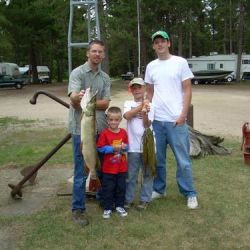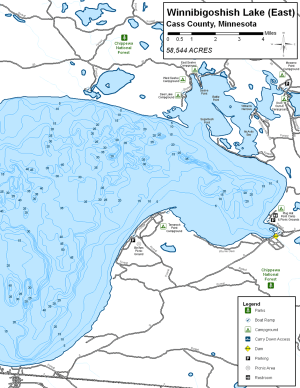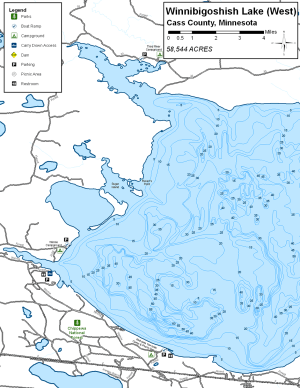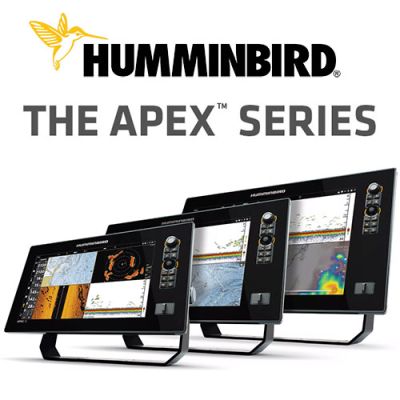Today's Best Fishing Times
Get the best fishing times for Lake Winnibigoshish with Lake-Link's Fishing Forecast. SEE MORE
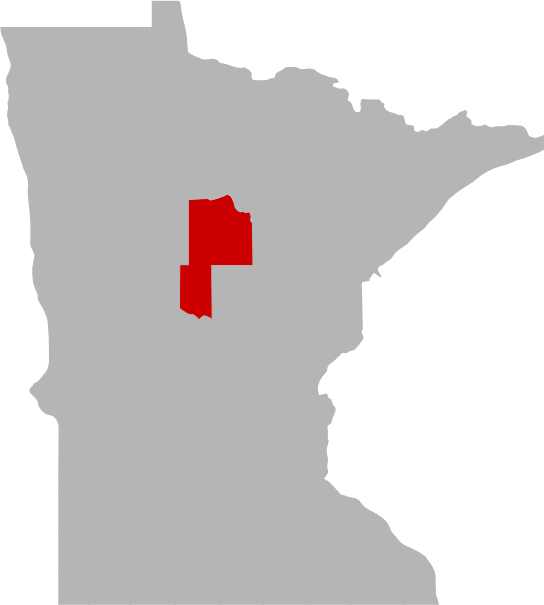
Lake Winnie is a popular destination for fishing, with several species of fish inhabiting the lake, including walleye, northern pike, muskie, perch, and crappie. Anglers can fish from shore or by boat, with several boat ramps and fishing piers located around the lake. The lake is also a popular destination for ice fishing during the winter months.
The lake is also popular for recreational boating, water sports, and swimming. There are several public beaches and parks located around the lake, as well as several resorts and campgrounds offering accommodations for visitors.
In addition to outdoor activities, the area around Lake Winnie is home to several small towns and attractions. The town of Deer River, located near the lake, offers a variety of shopping, dining, and entertainment options, as well as several museums and historic sites.
Overall, Lake Winnibigoshish is a beautiful natural resource and a popular destination for outdoor enthusiasts, offering a range of activities and attractions for visitors to enjoy.
Share your catch!
We want to see what you've caught on Lake Winnibigoshish.Frequently Asked Questions About Lake Winnibigoshish, MN
- How big is Lake Winnibigoshish?
- How deep is Lake Winnibigoshish?
- What kind of fish can you catch in Lake Winnibigoshish?
- Are there fishing guides or charters for Lake Winnibigoshish?
- Are there places to stay in the Lake Winnibigoshish area?
- Are there topographical lake maps available Lake Winnibigoshish?
- Are there boat launches on Lake Winnibigoshish?
- Are there places to eat and drink near Lake Winnibigoshish?
- What are the fishing regulations for Lake Winnibigoshish?
- What is the average air temp for Lake Winnibigoshish?
- Are there any state parks near Lake Winnibigoshish?
How big is Lake Winnibigoshish?
How deep is Lake Winnibigoshish?
What kind of fish can you catch in Lake Winnibigoshish?
Other fish species in the lake include Banded Killifish, Blackchin Shiner, Blacknose Shiner, Bluntnose Minnow, Brassy Minnow, Cisco (Tullibee), Common Shiner, Emerald Shiner, Fathead Minnow, Finescale Dace, Golden Shiner, Hybrid Sunfish, Iowa Darter, Johnny Darter, Lake Whitefish, Logperch, Mimic Shiner, Mottled Sculpin, Northern Redbelly Dace, Sand Shiner, Shorthead Redhorse, Silver Redhorse, Spotfin Shiner, Spottail Shiner, Tadpole Madtom, Trout-Perch and White Sucker.
Are there fishing guides or charters for Lake Winnibigoshish?
Are there places to stay in the Lake Winnibigoshish area?
More Lodging Options
Lake-Link Featured Lodging


Are there topographical lake maps available Lake Winnibigoshish?
Are there boat launches on Lake Winnibigoshish?
Lake Winnibigoshish area businesses:


Are there places to eat and drink near Lake Winnibigoshish?
What are the fishing regulations for Lake Winnibigoshish?
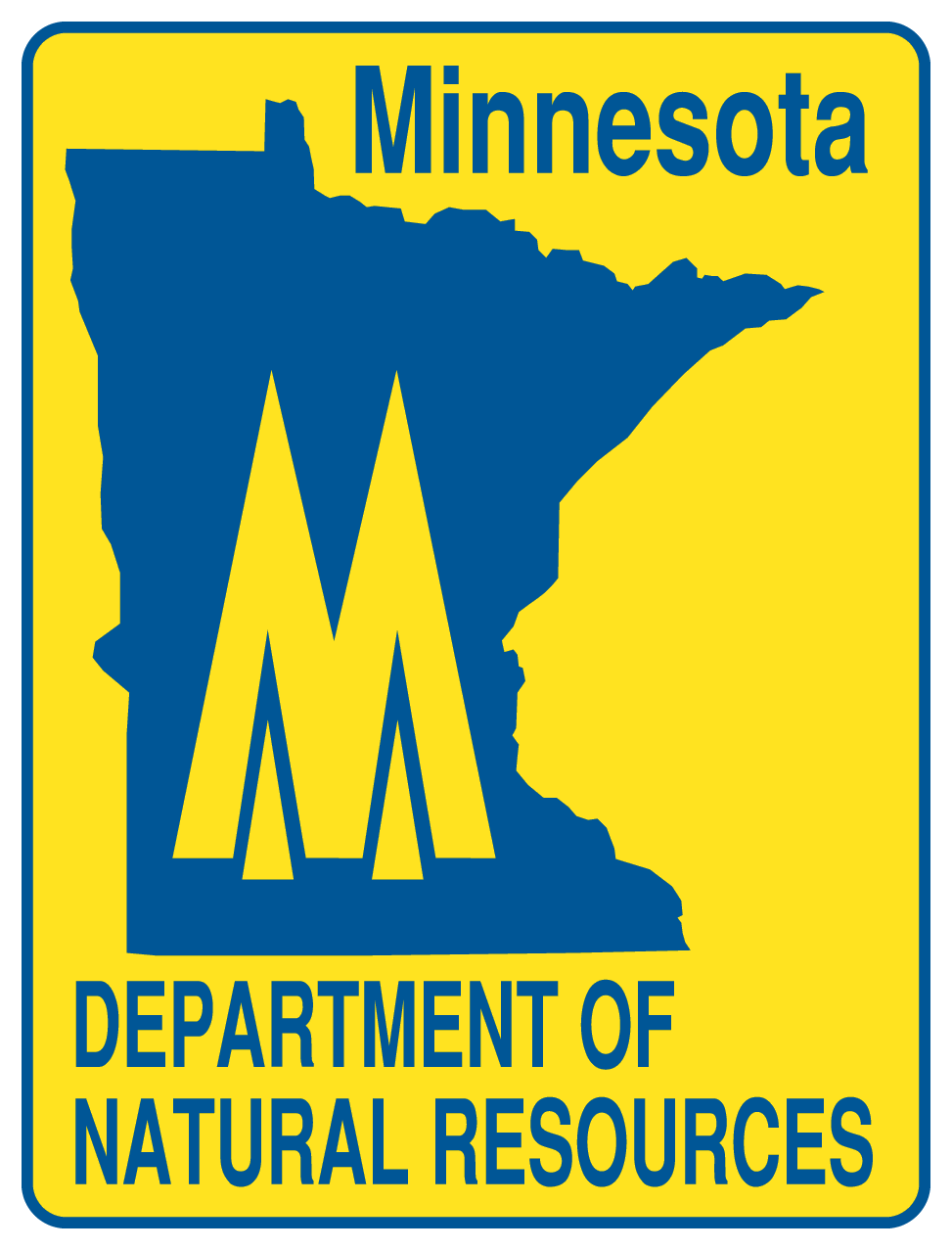 There are specific fishing regulations Lake Winnibigoshish that you need to know. For complete fishing regulations visit the Minnesota Department of Natural Resources. To report a violation call (800) 652-9093. Need a Minnesota fishing license?
There are specific fishing regulations Lake Winnibigoshish that you need to know. For complete fishing regulations visit the Minnesota Department of Natural Resources. To report a violation call (800) 652-9093. Need a Minnesota fishing license?
Explore the Lake Winnibigoshish area in a RV
Are you looking for an adventurous vacation option that won't break the bank? Look no further than renting an RV! Contrary to popular belief, the process is much simpler than you might imagine. With just a few easy steps, you'll soon be experiencing the ultimate freedom and convenience of exploring the open road in your very own recreational vehicle. And the best part? RV travel can save you up to 60% compared to other types of vacations! With the money you'll save, you'll be able to travel even more and create unforgettable memories along the way. So why wait? Start planning your next adventure today with an RV rental. Learn more about renting a RV.
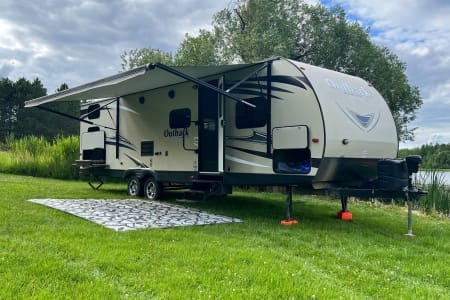
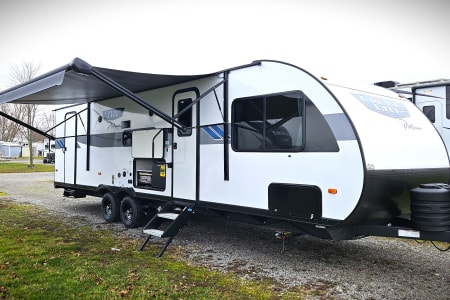
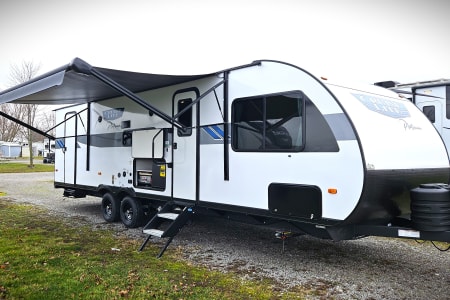
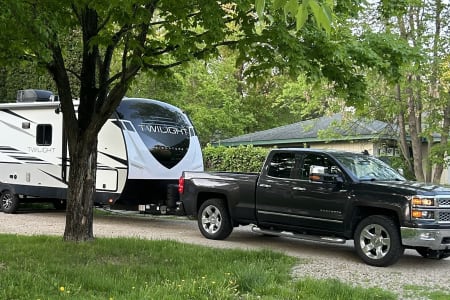
What aquatic invasive species are found in Lake Winnibigoshish?
Join us in the fight to prevent the spread of invasive species These sneaky creatures can hitch a ride on boats, clinging onto propellers, anchor lines, and trailers. They can even survive in hidden places like bilge water and ballast tanks, or disguise themselves in dirt and sand that sticks to nets, buckets, anchors, and waders. But don't worry, we have the power to stop them in their tracks with just a few simple steps. So let's do our part and protect our waters from these unwanted invaders.
History & Status of the Fishery
Lake Winnibigoshish is sampled annually to track changes in abundance and growth of fish species, and physical and chemical characteristics of the lake. The assessment season typically starts with seining and gill netting in late June to early July. The goal of seining is to sample young game and non-game species (including minnows) and to track growth of age 0 Walleye and Yellow Perch (perch). Gill netting is conducted from late June through July to sample game and non-game species age 1 and older. Abundance, growth rates, maturity, presence of parasites etc. is determined from these data. Trawling is conducted in August to continue tracking growth rates of age 0 Walleye and perch. Trawling gives the first clue to abundance of age 0 Walleye and perch for that year. Temperature and dissolved oxygen profiles are typically taken from June through August, and water chemistry analysis is completed in August to track changes in the system that may affect the ability of some species to prosper or exist in the lake. Plankton sampling was included in standard sampling beginning in 2012, and was continued through 2015. Six samples were taken on seven dates for a total of 42 samples in 2015. These samples were collected to determine baseline planktonic species composition and biomass.
Walleye; Walleye were sampled at a rate of 4.8 per net. Walleye sampled varied from 8.0 to 26.5 inches with a mean length of 17.0 inches and mean weight of 1.8 pounds. The Walleye population appeared to be healthy with most age-classes sampled between age 1 and 13. Walleye year-class strength was computed for fish from age 1 to 7. One average year class (2011), three strong year classes (2009, 2010, and 2013), and two weak year classes (2008, and 2012) were sampled. The 2012 year class of Walleye continues to be as weak as any year class observed since the start of the large lake program (1983). Poor Walleye year classes occur occasionally. Historic early ice out (March 30 - 2012) followed by a cold spring likely affected reproduction, and growth and survival of the 2012 year class.
Growth of Walleye was similar to the Lake Winnibigoshish and statewide average for all ages, attaining 17.7 inches after five growing seasons. The 17 to 26 inch protected slot limit was in place between 2000 and 2014. During this time, age and length at maturity increased from a low of 14.6 inches and 3.2 years, to 18.0 inches and 4.7 years. Spawning stock biomass increased from 0.5 lbs. per acre in 2002 to 2.7 lbs. per acre in 2013. This indicated that the Walleye population is likely fully recovered from a period of high harvest and reduced recruitment between the mid 1980's and mid 1990's. Due to this, the protected slot limit was changed to 18 to 23 inches in 2015 so that anglers could utilize the harvestable surplus.
The mean trawl catch rate of 2.5 Walleye per hour in 2015 declined by 45% from catch rates observed in 2013, and 2014. Catch rates from 2013 through 2015 were the lowest observed since 1983. Increased water clarity was observed during this time period, which appears to affect trawl catch rates. Fish of many species were observed avoiding the boat during trawling. Due to this (and to collect samples for the "Walleye Fry Stocking in Egg-Take Lakes" project) night electrofishing was conducted from late-August to mid- September. Electrofishing catch rates for 2013 through 2015 indicated higher abundance than trawl catch rates would indicate. Electrofishing catch rates in 2013 (88 per hour) were substantiated by higher than average catch of yearling Walleye in 2014 summer gill nets. Walleye may either avoid the trawl during years with high water clarity, or they utilize habitat that is not sampled by trawling.
Night electrofishing has been conducted primarily to collect young-of-the-year Walleye to augment sample size requirements for the "Walleye Fry Stocking in Egg-Take Lakes" project. Due to changes in water clarity and corresponding decreased trawl catch rates, electrofishing is being considered as an alternative sampling method to collect young Walleye. Electrofishing results from 2014 and 2015 are being used to standardize sampling locations and timing. The following results are from non-standard sampling and may not be comparable with future sampling events.
Results of electrofishing in 2015 were counter to those of trawling. Young of the year Walleye were sampled at a rate of 33 to 201 per hour (data available in the Grand Rapids Area Fisheries Office), and growth was good, reaching 6.6 inches on September 24th. Fast growth of age 0 Walleye often results in a strong year class.
Perch; Perch are an important species to anglers and as a prey item for predators. The catch of perch in assessment nets reached a historic low (at the time) in 2005, largely due to poor year-classes in 2000 and 2002. A strong 2003 year-class moved through the system resulting in higher catch rates through 2007. Catch rates declined from 2007 through 2011 to a new historic low catch of 43.6 per net. The catch rate for perch increased to 57.5 per net in 2012 and increased again to 74.4 in 2013. The gill net catch rate for perch declined to 53.9 per net in 2014. The gill net catch of perch declined to a new historic low of 43.1 fish per net in 2015.
Perch sampled in 2015 varied from 3.2 to 11.7 inches with a mean length of 6.9 inches and mean weight of 0.2 pounds. Age-classes 2 through 8 were sampled by gill nets. An index of year-class strength was computed for all year-classes sampled from 2008 through 2012. The 2011 year-class was weak while the 2008, 2009, 2010, and 2012 year-classes were average. Natural mortality of perch increases at age 8 and few individuals live past age 10. The catch of perch in 2015 was primarily represented by younger individuals with 85% of the catch made up of age 2 through age 4 fish. Although the perch population was composed primarily of small individuals, growth has not changed. Growth was relatively slow through age 2, then increased to average from age 3 to age 8. Perch grew to an average length of 9.3 inches at age 6.
Relative health of the perch population can be described by the percent of perch longer than 9 inches in the gill net catch. The gill net catch of large perch (longer than 9 inches) declined to 5.5% in the early 1990's driven by high angler harvest. Changes in Lake Winnibigoshish and other lakes prompted a statewide change in the perch bag limit to 20 daily and 40 in possession in 2001. Several strong year classes were produced during the same time period and the gill net catch of large perch increased to 30% in 2004. In 2005, the proportion of large perch sampled in near-shore gill nets declined for the first time since 1998. The proportion of large perch was about 17% in 2005 and 2006, then declined to 9.8% in 2007 as young perch from the 2003 year class were recruited to the fishery. No strong year classes were produced between 2004 and 2009. As a result the percent of large perch fluctuated between 10% and 13% between 2007 and 2012. A strong year class of perch was produced in 2010 (reduced to average by 2015). This resulted in increased gill net catch rates (mostly young fish) and a reduced catch of large perch (7.7%) in 2013. The catch of perch continued to be dominated by small young fish in 2014 and 2015. The perch catch of 7.8% longer than 9 inches in 2015 increased slightly from 6.8% in 2014.
The trawl catch rate for age 0 perch of 2,991 per hour was lower than any seen since 2005, and was the third lowest since 1987. Growth of age 0 perch was average with a mean length of 2.0 inches in mid-August. Clear water conditions that appear to have affected trawl catch rates of young of the year Walleye may have affected catch rates of young of the year perch also. Few age 0 perch were sampled in trawl hauls less than 10 feet of water. Catch rates of age 0 perch are typically highest in less than 8 feet. No correlation is evident between trawl catch rates or growth of age 0 perch and year-class strength.
The microsporidian parasite heterosporis has been documented in Lake Winnibigoshish perch. No evidence of heterosporis was observed in perch during the 2015 population assessment, although anglers report the presence of heterosporis in a few perch each year.
Northern Pike; Catch rates of Northern Pike (pike) showed an increasing trend from 1994 through 2005 and exceeded the third quartile (9.6 per net) in four years between 2002 and 2009. The pike catch rate was relatively stable and considered average between 2006 and 2011. Gill net catch rates increased dramatically between 2011 and 2014, reaching a new historic high of 14.1 per net in 2013. Catch rates continue to be above average in 2015 at 10.4 pike per gill net. Pike sampled in 2015 varied from 15.8 to 35.4 inches with a mean length of 21.3 inches. Mean length of pike has been declining as catch rates have increased. Mean pike length of 21.3 inches in 2015 increased from 2014 but was well below average. Age-classes from 1 through 5 and 7 were sampled by gill net. Growth rates were similar to the statewide mean through all ages.
Size structure of the pike population improved between 2010 and 2012. That trend was reversed in 2013 as a strong component of small young pike were recruited to the gill net catch. Two pike longer than 30 inches were sampled in the 2013 and 2014 assessment vs 10 in the 2011 and 9 in the 2012 assessments. Three pike longer than 30 inches were sampled in the 2015 assessment. Decreased size structure may be attributed to several causes. Reproduction and recruitment was strong for the 2011, 2012, and 2013 year classes which made up 94% of the catch, and Cisco abundance decreased due to summer kill in 2012 (Cisco are preferred prey that provides more energy than other similar size prey). A strong prey base of Cisco may lead to faster pike growth rates. High angler harvest of pike may result in a recruitment response (increased reproduction to replace individuals removed from the system). Larger numbers of small pike vs smaller numbers of medium to large pike may cause reduced growth rates due to increased competition for food and space. The recent increase in catch rate may result in slower pike growth in the future. Anglers can help maintain the pike size structure by releasing most pike longer than 22 inches.
Cisco; Cisco are a primary prey species for Muskellunge, pike and Walleye. Growth rates of these species may be reduced if Cisco are not present in the system. The gill net catch of 4.1 per net in 2015 was the lowest since 1983. Cisco sampled varied from 7.8 to 15.1 inches with a mean length of 10.0 inches. Cisco catch rates were lower than average for 7 of the last 10 years. This is likely due to warmer than average summer and fall water temperatures that may affect reproduction and cause occasional summer kills. Water temperatures were warm during the summer of 2012 and caused a summer kill of Cisco. Due to the low and decreasing catch rates discontinuation of Whitefish and Cisco Sport Gill Netting should be considered.
Water Quality; Five temperature and dissolved oxygen profiles were taken between June 22 and July 23, 2015. Dissolved oxygen stratification was evident on July 10th and July 17th. No evidence of thermal stratification was found in 2015. Thermal and dissolved oxygen stratification may result during periods of high air temperatures and low wind. When wind speeds increase to moderate levels (15 mph) the entire water column appears to mix. Water chemistry measurements have been recorded for most years since 1983. Water clarity as measured by Secchi disc in 2015 was the highest measured since 1983. Secchi disc measurements have varied between 12.5 and 19.0 feet. Total Phosphorous concentration can affect phytoplankton abundance which may affect water clarity. Total Phosphorous has remained within historic norms as water clarity increased over time. Recent increases in water clarity do not appear to be related to changes in Total Phosphorous concentration.
Invasive Aquatic Species; Invasive species are species that are not native to Minnesota and cause economic or environmental harm or harm to human health. Several invasive species have been introduced to Lake Winnibigoshish. Three species of snail: banded mystery, Chinese mystery, and faucet have become established since 2000. Both species of mystery snail appear to have no negative effect at this time. The faucet snail carries a trematode parasite that can kill several species of ducks if ingested. Thousands of ducks were killed by these parasites during the falls of 2007 and 2008. Emerald shiners (often used as bait) are not native to Lake Winnibigoshish and were first sampled in 2005. Juvenile zebra mussel (veliger), have been discovered while sampling plankton since 2012. Shoreline and mid lake areas of rock were investigated for adult zebra mussel in August of 2014 and 2015. No adult Zebra Mussel have been discovered in any assessments. Each of these invasive species were likely introduced through human activities.
What is the average air temp for Lake Winnibigoshish?
Are there any state parks near Lake Winnibigoshish?
For more Minnesota State Park information see our State Park Guide.
Lake Winnibigoshish Reviews
Below is the word on street about Lake Winnibigoshish.Have you been to Lake Winnibigoshish? Why not share your personal reveiw with others?
Submit Review
chad h.

david d.

brian s.

More Nearby Lakes To Explore
There's more lake's to explore around Lake Winnibigoshish...| DISTANCE | ACRES | MAX DEPTH | |
| Sugar Lake | 5.7 mi | 1,509 | 22 ft |
| Cut Foot Sioux Lake | 6.2 mi | 2,771 | 78 ft |
| Sunken Lake | 7.4 mi | 45 | 35 ft |
| Mosomo Lake | 7.8 mi | 48 | 30 ft |
| Little Winnibigoshish Lake | 8.0 mi | 1,002 | 28 ft |
| Lost Lake | 8.1 mi | 26 | 15 ft |
| Little Cut Foot Sioux Lake | 8.2 mi | 619 | 20 ft |
| Greeley Lake | 8.5 mi | 23 | 43 ft |
| Wilderness Lake | 8.8 mi | 22 | 25 ft |
| Middle Pigeon Lake | 9.0 mi | 182 | 25 ft |


 (7)
(7)

